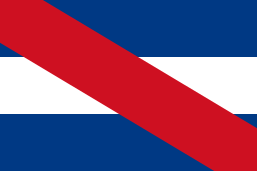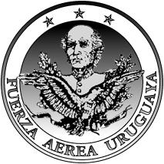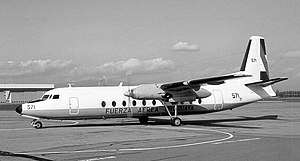Uruguayan Air Force
The Uruguayan Air Force (Spanish: Fuerza Aérea Uruguaya, abbreviated FAU) is the air branch of the Uruguayan Armed Forces. Initially part of the National Army, the current FAU was formed as an independent branch on December 4, 1953.
| Uruguayan Air Force | |
|---|---|
| Fuerza Aérea Uruguaya | |
 Uruguayan Air Force wings | |
| Founded | 1953 |
| Country | |
| Branch | Air Force |
| Type | Military aviation |
| Role | Aerial warfare |
| Size | 2,148 servicemen |
| Part of | Armed Forces of Uruguay |
| Nickname(s) | FAU |
| Motto(s) | Aviation vanguard of the homeland |
| Colors | Blue, red and white |
| March | FAU march |
| Mascot(s) | Southern lapwing |
| Anniversaries | 17 March: Air Force Day 10 August: Day of the Martyrs of Military Aviation |
| Aircraft | 89 |
| Website | fau.mil.uy |
| Commanders | |
| Commander in chief of the Air Force | Air Force General Alberto Zanelli |
| National Director of Civil Aviation and Aviation Infrastructure | Brigadier General Antonio Alarcón |
| Commander of Air Command Operations | Brigadier General Ismael Alonzo |
| Commander of Air Command Staff | Brigadier General Luis Pepelescov |
| Chief of General Staff | Brigadier General Hugo Marenco |
| Commander of the Air Logistics Command | Brigadier General José Visconti |
| Insignia | |
| Roundel |  |
| Fin flash |  |
| Aircraft flown | |
| Attack | A-37 Dragonfly |
| Helicopter | AS365 Dauphin UH-1 Iroquois Bell 212 |
| Reconnaissance | Cessna 206 |
| Trainer | SF.260 PC-7 Turbo Trainer Beechcraft Baron PA-18 Super Cub |
| Transport | C-212 Aviocar C-130 Hercules EMB-110 Bandeirante EMB-120 Brasilia Hawker 700 |
The FAU is in charge of exercising the sovereignty of the Uruguayan air space, defending the independence and peace of the Republic, the integrity of its territory, its constitution, its laws and also making the necessary logistical support in natural disasters that the country may suffer, always acting under the command of the President of the Republic, according to the Minister of National Defense.[1]
History
20th century
Military aviation in Uruguay was born on 17 March 1913 when the Military Aviation Academy (Escuela de Aviación Militar) was formed at a small airport 50 km from Montevideo. The first aircraft were a Farman Longhorn biplane and a Blériot XI monoplane. As with many other Latin American countries, flight instruction was initially performed by a European (in this case French) instructor. Ten army officers formed the select group chosen to be the first Uruguayan military aviators.
Among them were Cpt Juan Manuel Boiso Lanza and Lt. Cesáreo L. Berisso. Boiso Lanza was the first fatality of the FAU, dying in a plane crash on 10 August 1918; he later became the namesake of Cpt Boiso Lanza Air Base in Montevideo, the current FAU headquarters. Berisso became the first commander of the Air Force flight school and was later the namesake of Gen. Cesáreo Berisso Air Base in Carrasco, the headquarters of Air Brigade I.
Along with two other young officers, Adhemar Saenz Lacueva and Esteban Cristi, they gained their military aviator rating in Argentina and Chile and formed the Military Aeronautical School on 20 November 1916. This school was the only military aviation facility in Uruguay until 1935. Several European aircraft types were used in fairly large numbers during the twenties, among them sixteen Avro 504Ks, thirteen Breguet 14s, five Castaibert 913-IVs, twenty-eight Nieuport 27s. These pioneering years saw many air routes opened and an overall increase in the awareness of the military potential of this nascent force.
Military Aeronautics division
In 1935 the Military School of Aeronautics was transformed into a weapon dependent on the National Army, new units, air bases were created and it was named as Military Aeronautics.
The aircraft that were used during this period were Potez 25, A.2 TOE, Spad 13C.1, de Havilland DH.82 Tiger Moth and IMAM Ro.37 . In the following decade, until the year 1948, aircraft such as the Potez 25 remained in service, as did the de Havilland DH.82 Tiger Moth, which flew until 1949.
During 1942 Curtiss SNC-1 Falcon and North American T-6 Texan training aircraft began service, as did the Beechcraft AT-11 Kansan and Douglas C-47 Skytrain transports in 1947.
During the month of December 1949, members of a Uruguayan commission in charge of controlling the work to be carried out by the Grand Central Airport Company on North American B-25 Mitchell bombers and North American F-51 fighters were stationed in the United States. Mustang, which would be incorporated for service in Uruguay.
A total of 39 aircraft, among which were 25 North American F-51D Mustang and 11 North American B-25J Mitchell would arrive in the country between the years 1949 and 1950. They would later be integrated into Military Aeronautics with Aviation Groups No. 2 ( Hunting) and Nº3 (Bombardment).
The Uruguayan Air Force grew from this foundation. Later, some new units were created such as the Aerial Commands, but no radical changes were made. The FAU received its first jets when Lockheed T-33s and F-80s arrived in 1955 and 1958.[2] The FAU also employed the de Havilland Chipmunk, using 10 from 1954 to 1962. The first helicopters were Bell 47s and Hiller H-23Fs, followed by the venerable Bell UH-1B Hueys.
Creation of the Uruguayan Air Force

Finally, on December 4, 1950, with Law Nº12,070, the Uruguayan Air Force was created independently, and all the elements of infrastructure, material, personnel and items belonging to the Military Aeronautics, were transferred to the new Force. Air, as established in the first article of said law. It is from this moment that the aircraft begin to receive the inscription "Uruguayan Air Force" on their fuselages and the acronym "FAU" written on the upper part of their right wings. The Artigas Flag was kept at the helm of the aircraft . The figure of the Prócer de Uruguay, José Gervasio Artigas on a stamp of the Uruguayan Air Force. In 1956 Uruguay entered the jet age with the arrival of four Lockheed T-33 jet trainers. Training on these aircraft, Uruguayan pilots would then go on to fly Lockheed F-80 Shooting Star jet fighters. Both aircraft operated with Aviation Group No. 2 (Fighter) in Carrasco.
In 1959, the Uruguayan Military Air Transport (TAMU) was founded to complement the national airline PLUNA (First Uruguayan Air Navigation Lines ) to provide passenger and cargo services to different cities in the interior of the country as well as abroad. This service began to operate with the Douglas C-47 Skytrain . TAMU subsequently operated with Fokker F-27, Fairchild Hiller FH-227, CASA C-212 Aviocar and Embraer EMB 110 Bandeirante aircraft . The Uruguayan Air Force grew in this foundation and later some new units such as the Air Commandos were created, but no radical changes were made.
In 1973, the Air Force received its first Bell UH-1 turbine helicopters, and in 1975, a total of five Embraer EMB 110 Bandeirantes were acquired, making it the first Embraer export in its entire history. In 1976 the combat fleet would be reinforced with the arrival of a total of 8 Cessna A-37B Dragonfly, and in 1980 that of helicopters with the arrival of two Bell 212s. Embraer's first export. Delivery of the first Bandeirantes to the Uruguayan Air Force. São José dos Campos, Brazil, 1975. In 1981, seeking to replace its veterans Douglas C-47 Skytrain, the Uruguayan Air Force acquired five CASA C-212 Aviocar in Spain, and the first FMA IA-58 Pucará would join the combat fleet .
Aiming for aerial photography and presidential relocation missions, a Gates Learjet 35 was purchased, but due to high maintenance costs, the aircraft was finally sold in 1988.
During 1992 two Lockheed C-130 Hercules were incorporated to carry out long-range missions and six Pilatus PC-7 Turbo Trainer trainers, which replaced the Beechcraft T-34 Mentors in the advanced flight training phases.
In 1998 the Air Force acquired two Beechcraft Baron 58s and Uruguay became the first operator of the Cessna 206H, of which a total of 10 units were received. The following year, the Air Force selected the Aermacchi SF-260 as its new basic trainer, and a total of 13 aircraft were purchased to replace the Beechcraft T-34 Mentors of the Military School of Aeronautics.
Uruguayan Sovereign airspace
In 1919 the Paris Convention on Air Navigation was signed . It establishes that every state has sovereignty over the airspace above its territory. The territorial sea is included . Regular air services - commercial lines - must be authorized by the states. In other words, the overflight, the right to disembark and board passengers, merchandise, mail, etc., must be expressly authorized. Land is allowed for non-commercial reasons, to resupply, or in an emergency.
Present state of the Air Force
A substitute for the two Lockheed C-130B is needed in near time, despite the Program Depot Maintenance(PDM) and major upgrade realized by Chilean aircraft manufacturer ENAER.[3][4] Candidates are the EADS CASA C-295 and possibly Shaanxi Y-8 despite no official statement has been done. In the medium and light transport branch Bandeirantes are being restored to flight by Algar Aviation in Brazil since the end of 2013.[5][6] In 2009 two CASA C-212 were bought from Sweden as a temporary solution and another two former-Portuguese Air Force C-212-300 are to be incorporated in 2015.[7][8] China has offered Harbin Y-12 and rumours about a purchase of some Cessna 208 were denied recently.
The Uruguayan Air Force is looking for a new fighter plane as its fleet of Dragonflies are reaching the end of their operative life. In May 2013 eighteen refurbished Sukhoi Su-30 MkI were offered by the Russian Federation and Sukhoi in remarkably favorable conditions that included credit facilities and an agreement branch for maintenance. These conditions were offered for the Yak-130 Mitten, too. By December 2013 Uruguayan personnel flew this plane in Russia.[9] Current negotiations are ongoing.[10]
According to Scramble a number of A-37B Dragonfly were purchased from the Ecuadorian Air Force in January 2014. In August 2014 the Uruguayan and Swiss governments discussed a possible agreement for the purchase of ten Swiss Air Force Northrop F-5 plus engines, spare parts and training.[11]
Also, the FAU showed interest on the IA-58D Pucará Delta modernization program offered by Fábrica Argentina de Aviones.[12]
Aerodromes and Air Bases
- SUDU - Tte. 2nd Mario W. Parallada, Santa Bernardina, Durazno.
.jpg) I Air Brigade, Canelones.
I Air Brigade, Canelones. - SUMU - Air Brigade I, Carrasco International Airport "Gral. Cesáreo L. Berisso" .
- SUBL - Cap. Juan Manuel Boiso Lanza.
- SUGA - General Air Base Artigas.
- SUCL - La Calera.
- SUCR - La Carolina.
- SULP - La Paloma
Organization
Today the FAU comprises about 3000 personnel organized into three brigades and various support groups.
- Air Brigade I was founded as Nº1 Aeronautics on 1 April 1936. It originally consisted of eight Potez XXV biplanes. Today, the brigade includes the Central Office for Assistance and the Carrasco Central Coordinator for Rescue. It also includes
- Nº3 Squadron (Transport) and
- Nº5 Squadron (Helicopters). A Uruguayan tactical air controller, keeps watch over a USAF OA-37 during a training exercise
- Air Brigade II includes
- Nº1 Squadron (Attack),
- Nº2 Squadron (Fighters),
- the Advanced Flight Squadron, and
- the Liaison Squadron.
- Air Brigade III includes
- Nº7 Squadron (Observation & Liaison).
The Uruguayan Air Force also includes Service divisions for Logistics, Communications and Computer Science, Information, Infrastructure, Maintenance, Meteorology, Health, Remote Aerospace Sensors, and Transport. The FAU is involved in search and rescue, disaster assistance, and transportation to remote locations within the country.
The Uruguayan Air Force currently has five bases. Air Brigade I is based at Gen. Cesáreo L. Berisso Air Base at Carrasco International Airport (SUMU) near Carrasco; Air Brigade II is based at 2nd Lt. Mario W. Parrallada Air Base at Santa Bernardina International Airport (SUDU) in Durazno; Air Brigade III, the high command, and the Command School (Escuela de Comando y Estado Mayor Aéreo) are based at Capitán Boiso Lanza Air Base (SUBL) in Montevideo; Air Squadron 7 is based at Ángel S. Adami Airport (SUAA), also in Montevideo; and the EMA is based at Gen. Artigas Air Base (SUAG) in Pando.[13]
The Aeronautics Technical School (Escuela Técnica de Aeronáutica) is located in Toledo Sur in the Department of Canelones.[14]
Aircraft
Current inventory
_Lofting.jpg)
.jpg)
| Aircraft | Origin | Type | Variant | In service | Notes | |
|---|---|---|---|---|---|---|
| Combat Aircraft | ||||||
| Cessna A-37 | United States | attack | 12[15] | |||
| Transport | ||||||
| Harbin Y-12 | China | transport | 2 on order[16] | |||
| C-130 Hercules | United States | transport | C-130B | 2[16] | ||
| CASA C-212 | Spain | transport | 200 / 300 | 3 / 2[17] | ||
| Beechcraft Baron | United States | utility | 55 / 58 | 1 / 2[18] | ||
| Cessna 206 | United States | light transport | U-206H | 6[19] | ||
| Embraer EMB 120 | Brazil | utility / VIP | 1[16] | Presidential aircraft | ||
| Embraer EMB 110 | Brazil | utility / transport | 2[16] | |||
| Helicopters | ||||||
| Bell 212 | United States | utility | 4[16] | |||
| Bell UH-1 | United States | utility | UH-1H | 3[16] | ||
| Eurocopter AS365 | France | SAR / utility | 2[16] | also used for Presidential transport[20] | ||
| Trainer Aircraft | ||||||
| Pilatus PC-7 | Switzerland | trainer | 5[16] | |||
| SIAI-Marchetti SF.260 | Italy | trainer | 12[21] | |||
Rank structure
Officers wear their rank insignia on their sleeves; the insignia are nearly identical to that used by the RAF and air forces of Commonwealth nations.[22]
| Equivalent NATO Rank Code | Rank in Spanish | Rank in English | Commonwealth equivalent | US Air Force equivalent |
|---|---|---|---|---|
| OF-8 | Teniente General | Lieutenant General | Air Marshal | Lieutenant General |
| OF-7 | Brigadier General | Major General | Air Vice-Marshal | Major General |
| OF-5 | Coronel | Colonel | Group Captain | Colonel |
| OF-4 | Teniente Coronel | Lieutenant Colonel | Wing Commander | Lieutenant Colonel |
| OF-3 | Mayor | Major | Squadron Leader | Major |
| OF-2 | Capitán | Captain | Flight Lieutenant | Captain |
| OF-1 | Teniente Primero | First Lieutenant | Flying Officer | First Lieutenant |
| OF-1 | Teniente Segundo | Second Lieutenant | Pilot Officer | Second Lieutenant |
| OF-D | Alférez | Ensign | Acting Pilot Officer |
Accidents and incidents

The following is a list of air accidents involving the Uruguayan Air Force.
- On October 13, 1972, the Flight 571 of TAMU an FH-227D, registered as FAU 571 , which was carrying a group of rugby players Uruguayans Old Christians, made up of alumni of the school Stella Maris, from Uruguay to Chile, it crashed in the Andes Mountains due to a controlled flight against the ground, killing 29 of the 45 people on the plane, including the 5 crew, surviving only 16 of them. The survivors were finally rescued on December 23, 1972 after 72 days in the Andes.
- On October 9, 2009, one C-212 Aviocar, registered as A-146 ( FAU 531 ) (which was part of the mission MINUSTAH of the UN ) crashed while he was conducting a reconnaissance mission in the south of Haiti, after the air traffic controllers at the base lost all contact with the aircraft, when it was flying over the town of Ganthier. The remains of the Aviocar were located from the air, by another aircraft that was sent after the search and rescue systems were alerted. 11 soldiers died in this accident, six Uruguayans and five Jordanians.[23]
- On August 12, 2016, a Cessna A-37B with registration "FAU 273" was conducting a training mission when it crashed to the ground from 2,700m, both pilots were killed on the spot. the causes of the accident are still unknown.[24]
- On August 16, 2016, a UH-1H "Iroquois" helicopter of the Uruguayan Air Force crashed at the Carrasco airport during a training of self- rotation maneuvers where its two crew members subsequently died. The cause of the accident is under investigation.[25]
See also
- Armed Forces of Uruguay
- History of Uruguay
- National Navy of Uruguay, which includes a Naval Aviation contingent
- Uruguayan Air Force Flight 571
References
| Wikimedia Commons has media related to Air force of Uruguay. |
Notes
- Fuerza Aérea Uruguaya, (2008). Archived 2008-10-14 at the Wayback Machine. Retrieved 2 October 2008.
- Air International August 1990, p. 73.
- "Actualizado: ENAER modernizará aeronaves C-130B de la FAU" (in Spanish). ModoCharlie. October 7, 2011. Archived from the original on April 2, 2015. Retrieved December 21, 2014.
- "La Fuerza Aérea Uruguaya contrata a ENAER para el mantenimiento de un C-130B Hercules" (in Spanish). April 20, 2012. Archived from the original on April 2, 2015. Retrieved December 21, 2014.
- "La Fuerza Aérea Uruguaya continúa ejecutando su plan de mantenimiento de aeronaves" (in Spanish). InfoDefensa. September 24, 2013. Archived from the original on March 3, 2015. Retrieved December 21, 2014.
- "La Fuerza Aérea Uruguaya repara y adquiere repuestos para sus aeronaves" (in Spanish). Paz la Nueva Radio. November 28, 2013. Archived from the original on April 2, 2015. Retrieved December 21, 2014.
- "La Fuerza Aérea Uruguaya confirma la compra de aviones C212-300MP" (in Spanish). InfoDefensa. July 31, 2014. Archived from the original on March 31, 2015. Retrieved December 21, 2014.
- "Portugal y Uruguay suscriben el contrato de transferencia de dos C212-300 para la FAU" (in Spanish). Defensa. December 19, 2014. Archived from the original on April 2, 2015. Retrieved December 21, 2014./
- "La Fuerza Aérea Uruguaya evalúa el jet de entrenamiento YAK-130 en Rusia" (in Spanish). December 12, 2013. Archived from the original on November 12, 2014. Retrieved December 21, 2014.
- "Mujica negocia la compra de seis aviones rusos para Fuerza Aérea" (in Spanish). El Observador. July 15, 2014. Retrieved December 21, 2014./
- "F-5 suizos a Uruguay" (in Spanish). August 21, 2014. Archived from the original on March 4, 2016. Retrieved December 21, 2014.
- "Argentina y Uruguay estudiaron la modernización de los aviones IA-58 Pucará" (in Spanish). July 10, 2014. Archived from the original on December 21, 2014. Retrieved December 21, 2014./
- Aeroflight, (2008). Archived 2008-12-07 at the Wayback Machine. Retrieved 2 October 2008.
- Fuerza Aérea Uruguaya, (2008). Archived 2008-10-15 at the Wayback Machine. Retrieved 2 October 2008.
- "Cessna A-37B "Dragonfly"". fau.mil.uy. 5 February 2018. Retrieved 3 June 2020.
- "World Air Forces 2020". Flightglobal Insight. 2020. Retrieved 2 June 2020.
- "Airbus C-212 "Aviocar"". fau.mil.uy. 20 August 2018. Retrieved 3 June 2020.
- For Baron 55, see "Beechcraft UB-55 "Baron"". fau.mil.uy. 20 August 2018. Retrieved 3 June 2020.
For Baron 58, see "Beechcraft UB-58 "Baron"". fau.mil.uy. 20 August 2018. Retrieved 3 June 2020. - "Cessna U-206 H "Stationair"". fau.mil.uy. 4 February 2018. Retrieved 3 June 2020.
- "Airbus AS-365 "Dauphin"". fau.mil.uy. Retrieved 2 June 2020.
- "Aermacchi SF-260 (T-260)". fau.mil.uy. 20 August 2018. Retrieved 3 June 2020.
- "Insignias". Archived from the original on 2011-07-27. Retrieved 2011-05-05.
- ""Falla humana" provocó accidente aéreo en Haití en octubre de 2009". LaRed21 (in Spanish). 4 June 2010. Retrieved 5 June 2020.
- "Cayo aeronave de la FAU en Durzano: Fallecieron sus dos tripulantes". Elacontecer.com.uy (in Spanish). 12 August 2016. Retrieved 5 June 2020.
- "Un helicóptero de la Fuerza Aérea se cayó en el Aeropuerto de Carrasco: murieron los dos pilotos". Telemundo (in Spanish). 16 August 2016. Retrieved 5 June 2020.
Bibliography
- "Shoestring Top Cover...The Uruguayan Air Force". Air International, Vol. 39 No. 2, August 1990. pp. 65–73.
External links
- Fuerza Aérea Uruguaya - Official website (in Spanish)
- "Memories from the Age of Flight" (in Spanish)
- The Fuerza Aerea Uruguaya in Microsoft Flight Simulator FS2004 (in Spanish)
- Aeroflight: Uruguay Air Force